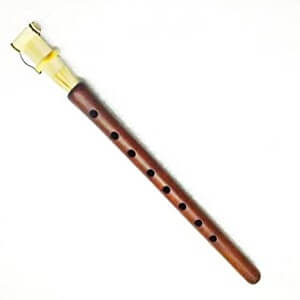Balaban
 Balaban, a cylindrical-bore, double-reed wind instrument about 35 cm long with seven finger holes and one thumb hole, played in eastern Azerbaijan in Iran and in the Republic of Azerbaijan [the former Soviet Azerbaijan] (where it is also called düdük). This instrument can be made of mulberry or other harder woods, such as walnut. The bore through the instrument is about one and a half cm in diameter. The double reed is made out of a single tube of cane about six cm long and pressed flat at one end. The performer uses air stored in his cheeks to keep playing the bālābān while he inhales air into his lungs. This “circular” breathing technique is commonly used with all the double-reed instruments in the Middle East.
Balaban, a cylindrical-bore, double-reed wind instrument about 35 cm long with seven finger holes and one thumb hole, played in eastern Azerbaijan in Iran and in the Republic of Azerbaijan [the former Soviet Azerbaijan] (where it is also called düdük). This instrument can be made of mulberry or other harder woods, such as walnut. The bore through the instrument is about one and a half cm in diameter. The double reed is made out of a single tube of cane about six cm long and pressed flat at one end. The performer uses air stored in his cheeks to keep playing the bālābān while he inhales air into his lungs. This “circular” breathing technique is commonly used with all the double-reed instruments in the Middle East.
Sometimes a blow is added to 2 B. tools (dyaf, carbon deposits). In B. they perform melodies of songs, dances, instruments. plays. B. is included in the orchestras and ensembles of the nar. tools. The varieties of B. are duduk (Armenia; in Georgia, duduks) and balaban (Dagestan). In the finished body (barrel) of the tool, 8 holes are drilled on the front side and one on the back. When playing the instrument, the performer opens and closes the holes with the fingers of both hands.
Balaban is a mouthpiece instrument; a mouthpiece is put on its head, made of reed in certain sizes and flattened on one side, which is why this instrument is sometimes called "yasty (ie flat) balaban". With the help of a clamp, put on the mouthpiece, the musical structure of the instrument and the pitch of the sound are regulated. To extract sound from the instrument, the performer draws air into the oral cavity and, with great skill, directing it into the mouthpiece located between his lips, and also by moving your fingers through the holes, it achieves the desired pitch. The total length of the tool is 280-300 mm, the diameter is 20-22 mm.